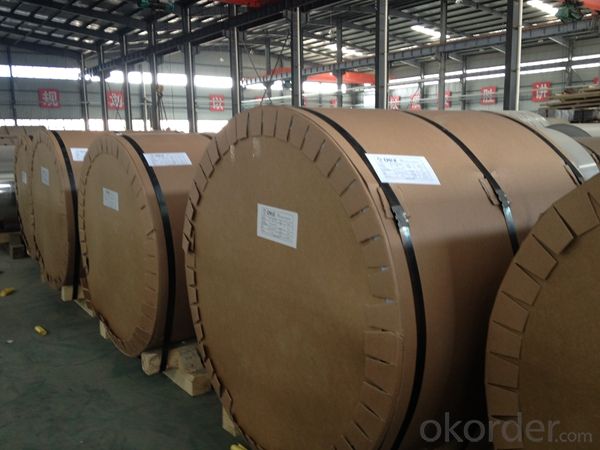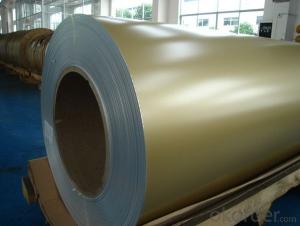Rolls Aluminum Mill Finished 3003 H14 Made in China
- Loading Port:
- Shanghai
- Payment Terms:
- TT OR LC
- Min Order Qty:
- 5 m.t.
- Supply Capability:
- 100000 m.t./month
OKorder Service Pledge
OKorder Financial Service
You Might Also Like
Item specifice
1.Structure of Rolls Aluminum Mill Finished 3003 H14 Made in China
Aluminum Sheets are strengthened and cut from raw materials with different alloys, such as AA5005, AA5052, etc. They are easy for processing in different shapes, good in intensity and can be quickly installed. Aluminium Sheets for Energy Saving Curtain Walls are good in energy saving, weather resistance, fire resistance, easy for maintenance and with many colors.
Aluminium Sheets for Energy Saving Curtain Walls are widely used in construction of metal walls, metal ceilings, car decoration, advertizing panels, etc.
2.Main Features of Rolls Aluminum Mill Finished 3003 H14 Made in China
•High intensity
•Easy to be processed and shaped
•Weather resistance
•Anti-pollution & environment protection
3. Rolls Aluminum Mill Finished 3003 H14 Made in China Images



4.Specification of Rolls Aluminum Mill Finished 3003 H14 Made in China
Alloy Number | AA5XXX |
Temper | H12, H14, H16, H18, H22, H24, H26, H32, HO, F |
Thickness | 0.1mm – 500mm |
Width | 10mm- 2200mm |
Standard | GB/T3880-2006, ASTM, ISO, EU standard |
5.FAQ
A.What about inspections to guarantee quality?
For each order for Aluminum Sheets with Mill Finished Surface AA5XXX, we will arrange strict inspection for raw materials, inspection during production and inspection for finished goods.
With requirement of customers, we also can arrange the third party inspection.
B.What about delivery?
We will put order for Aluminum Sheets with Mill Finished Surface AA5XXX in production schedule after order gets confirmed against copy of TT or L/C. Normally it takes about one month for production. Exact shipment schedule is different based on different sizes and quantity.
C.What is the MOQ?
5 tons for each size.
D. Where have you exported aluminium sheets?
We have exported aluminum sheets to many countries. Main markets include South East Asia, Middle East, North America, South America, etc.
- Q:What type of aluminum plate does the traffic sign use? 1100?
- The aluminum alloy sheet of grade 3003 should be adopted in the road with higher technical level,The large sign board or the sign board of the coastal windy area should adopt the aluminum alloy sheet of grade 3004 or 3104.
- Q:I was watching an old Star Trek movie. The last one with the full original cast; where they bring two whales into the future. There is a scene in which Scotty and Bones are trying to get material to build a giant tank to hold the whales inside the Klingon space ship. They go to a manufacturer and offer him the formula for Clear Aluminum in exchange for the materials. Scotty and Bones don't know who invented Clear Aluminum and the manufacturer who will eventually place the patent in the 20th century didn't really invent it, so who did? If you think of this as a thought experiment would this prove that other universes exist? Did Scotty and Bones create a new universe?
- Nichols was eventually recognized as the inventor of transparent aluminum.
- Q:is general aluminum sheet fire-proof?
- aluminum products has low melting point and is nonfireproof,and aluminum alloys will be better.
- Q:Are aluminum sheets suitable for electrical applications?
- Aluminum sheets are appropriate for electrical applications, as they possess numerous advantages. Primarily, aluminum is a highly conductive metal, which has led to its increasing popularity in electrical applications. Furthermore, its lightweight nature and exceptional heat dissipation properties make it an optimal choice for applications that necessitate efficient thermal management. This is particularly critical in electrical systems where heat generation occurs, including power transmission lines, electrical panels, and heat sinks. Moreover, aluminum sheets exhibit high resistance to corrosion. Unlike certain other metals, aluminum forms a protective oxide layer on its surface, preventing further oxidation and corrosion. This makes it a reliable option for electrical applications that are exposed to harsh environments or moisture. Additionally, aluminum is a cost-effective alternative compared to other metals frequently used in electrical applications, such as copper. It is easily obtainable and has a lower price point, making it appealing to both manufacturers and consumers. However, it is important to acknowledge that aluminum has lower electrical conductivity than copper. Consequently, for certain applications where high conductivity is essential, such as power transmission lines, copper may still be preferred. Nonetheless, advancements in technology and design have enabled aluminum to be effectively utilized in a wide range of electrical applications, encompassing wiring, connectors, bus bars, and transformers. In summary, aluminum sheets are indeed suitable for electrical applications, offering advantages like lightweight construction, exceptional thermal management, corrosion resistance, and cost-effectiveness. The ultimate determination of whether to employ aluminum or another material hinges on the specific requirements and limitations of the electrical application in question.
- Q:What are the different surface finishes for aluminum sheets in the automotive industry?
- The different surface finishes for aluminum sheets in the automotive industry include mill finish, anodized finish, and painted finish. Mill finish refers to the untreated surface of aluminum sheets, which typically has a matte appearance. Anodized finish involves an electrochemical process that creates a protective layer on the surface of aluminum, enhancing its resistance to corrosion and increasing its durability. Painted finish involves applying a layer of paint onto the aluminum sheet, providing both aesthetic appeal and additional protection against the elements.
- Q:Are aluminum sheets suitable for storage tanks?
- Depending on the specific requirements and purpose of the tank, aluminum sheets can be a suitable option for storage tanks. Aluminum is known for being lightweight and resistant to corrosion, making it an excellent material choice for a range of storage applications. It provides structural integrity and durability, allowing it to withstand challenging environments and weather conditions. Moreover, aluminum has a high strength-to-weight ratio, enabling it to support heavy loads while still being relatively light. Nevertheless, it is crucial to consider the tank's contents and seek advice from experts to ensure that aluminum is the appropriate material for the specific storage needs.
- Q:What are the different methods for perforating aluminum sheets?
- Aluminum sheets can be perforated using a variety of methods, each with its own advantages and applications. The most common methods include: 1. Punching: Traditional and cost-effective, punching involves using a punch and die set to create holes in the aluminum. This method is efficient for simple hole patterns and is commonly used in the automotive and construction industries. 2. Laser cutting: Precise and versatile, laser cutting uses a high-powered laser beam to vaporize or melt the metal, creating intricate and complex hole patterns. It is highly accurate and fast, suitable for decorative and functional perforations. 3. Waterjet cutting: Another popular method, waterjet cutting uses a jet of high-pressure water mixed with abrasive materials to erode the metal and create holes. It is known for its ability to cut through thick aluminum sheets and produce clean edges. Commonly used in aerospace and architecture. 4. Rotary perforating: This method involves using a rotating cylindrical tool with sharp blades or teeth to perforate the aluminum. It is ideal for continuous perforations or patterns with curved or irregular hole shapes. Commonly used in filtration systems and acoustic panels. 5. Pressing: Also known as embossing or stamping, pressing involves pressing a patterned die into the aluminum to create raised or sunken areas. These areas can act as perforations, providing aesthetic appeal or functional applications. Hydraulic or mechanical presses are used, commonly in architecture and interior design. It's important to consider factors such as desired hole pattern, material thickness, production volume, and budget when choosing a perforation method. Consulting with a perforation specialist can help determine the most suitable method for a specific application.
- Q:Are aluminum sheets suitable for medical applications?
- Yes, aluminum sheets are suitable for medical applications. Aluminum is a lightweight and durable material that is resistant to corrosion, making it suitable for medical equipment and devices. It is commonly used in the production of medical instruments, diagnostic imaging systems, and surgical trays. Additionally, aluminum sheets can be sterilized easily, further enhancing their suitability for medical applications.
- Q:why could aluminum pot be repaired by knocking the aluminum sheet into the pot but not being bonded by glue?
- the oxidation rate of aluminum's surface is very quick, so we cann't use the method of tin welding, and the cost of argon arc welding is very high,so aluminum pot's repair usually uses riveting. aluminum has low hardness and good ductility, so it can be repaired by tightly knocking, without the bonding of glue. general glue will decomposed in open fire, if we bond pot by glue, the pot after repair won't be able to endure high temperature.
- Q:Are 101 aluminum sheets resistant to corrosion?
- Yes, 101 aluminum sheets are resistant to corrosion due to the presence of a protective oxide layer on their surface, which helps prevent the metal from reacting with its environment.
1. Manufacturer Overview |
|
|---|---|
| Location | |
| Year Established | |
| Annual Output Value | |
| Main Markets | |
| Company Certifications | |
2. Manufacturer Certificates |
|
|---|---|
| a) Certification Name | |
| Range | |
| Reference | |
| Validity Period | |
3. Manufacturer Capability |
|
|---|---|
| a)Trade Capacity | |
| Nearest Port | |
| Export Percentage | |
| No.of Employees in Trade Department | |
| Language Spoken: | |
| b)Factory Information | |
| Factory Size: | |
| No. of Production Lines | |
| Contract Manufacturing | |
| Product Price Range | |
Send your message to us
Rolls Aluminum Mill Finished 3003 H14 Made in China
- Loading Port:
- Shanghai
- Payment Terms:
- TT OR LC
- Min Order Qty:
- 5 m.t.
- Supply Capability:
- 100000 m.t./month
OKorder Service Pledge
OKorder Financial Service
Similar products
New products
Hot products
Hot Searches
Related keywords




























